The Zeisset Family in Germany
Written by
Loretta M. Hoerman
Forward
When is
a family history ever finished? With the Internet as the forum for our
Zeisset family history, we can continue to modify the information we
have presented as new information is discovered. This current
presentation is a compilation of existing text which remains pertinent
and new material. With continued research, errors have been found in
what was previously written. One of the most significant errors in the
2006 version of this narrative was the information regarding Lydia
Zeisset. While the information was correct, she was assigned to the
wrong family. With research over the past year, she has been paired up
with the correct family and the story remains valid. We’ve also been
able to expand our Zeisset family to include the continent of South
America. As the information is expanding, new chapters are being
created to make the information more readable. The first part of
Chapter 1 remains unchanged at this time, but from there on, new
information is added to what was already known and corrections are made
so that the reader will have to review all of the information in order
to find the new material. The most significant additions this year
(2008) are the expanded information regarding the siblings of Jakob
Friedrich Zeisset (1837-1884) and additional information about the farm
at Kreuzfeld, including a floor plan for the house, as well as the
knowledge of the final resting place for Jakob Friedrich Zeisset. A
chapter has also been included on the Heinrich Zeisset family. I remain
grateful for the initial inspiration from Merton Zeisset and his book
from 1992 Our First Century in America,
as well as German researchers Kurt Jäger and Dr. Elisabeth Kludas who
have been immensely helpful in breaking down brick walls. I am also
grateful for the help I receive when I walk up to a house in Germany,
knock on a door and say, “My ancestors used to live here” and am
welcomed into the home and given whatever information they have. I
appreciate every scrap of information received from all family members.
Moreover, I remain inspired and challenged by the readers’ persistent
curiosity and support and thank you for encouraging my research.
Chapter 1 ...
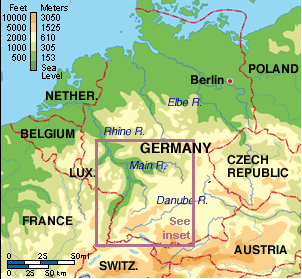
Orientation map |
The Zeisset family came from Switzerland settling
first at the Rauhof in 1660-1670. This
is according to typewritten records dated 1939 from a relative of
Raphael Zeisset-Alfred
Funk (1905-1971). Our ancestors were of the Mennonite religion. The
original spelling
of the name was Zyßet (Zysset). Several variations on the name
followed, including
Zeisset, Zeissert, Zeiset, Zeisert and even Zersert. The first known
Zeisset at the Rauhof
was Jakob Zeisset in about 1680. The only information about Jakob
Zeisset is his name
and a date. Then Abraham Zeisset from Rauhof was chosen as pastor in
neighboring
Hasselbach in 1731.
Before the Thirty Years War (1618-1648), there were
few, if any, Mennonites in the
Kraichgau. The Kraichgau region is in the southwest part of Germany
between the
Neckar and Rhine rivers, lying in the former German state of Baden.
After the war,
because of the need to rebuild and the loss of so many German lives,
Mennonites were
offered refuge and partial religious freedom in the Kraichgau in 1664.
People of the
Mennonite faith found tolerance here, at least some tolerance
compared to what they’d
found at the hands of the Swiss. Other families who relocated to the
Kraichgau from
Switzerland included the following names: Baer, Landes, Horsch,
Bachmann, Fellmann,
Schmutz, Funck, Hege and Kreiter, Kaufmann, Hodel, Heer, Mosemann,
Duersstein,
Frey. Most of these families were from the area in and around Bern.
Members of these
families would join in communities along with the Zeissets and
therefore some of these
are names found among the Zeisset spouses.
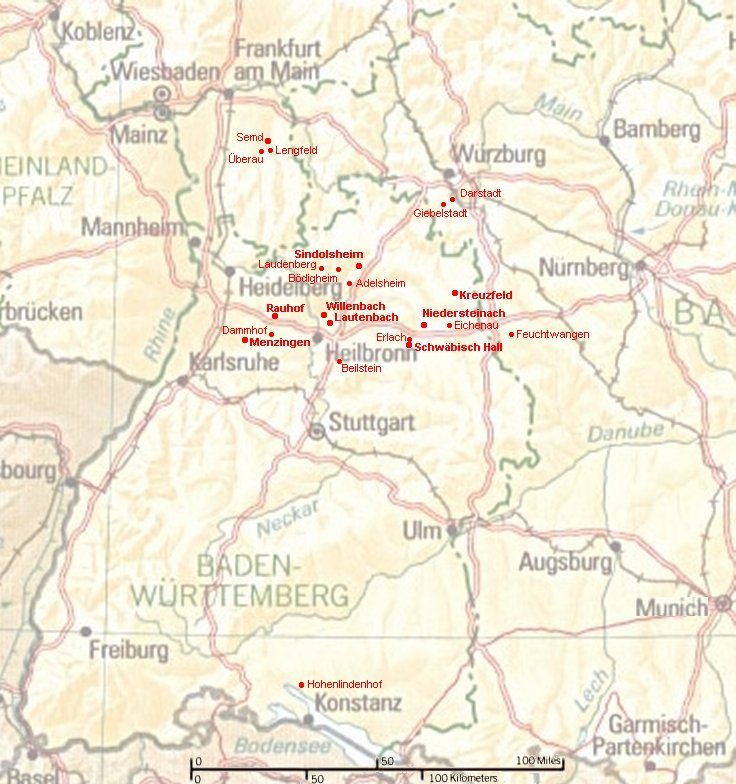
Key Zeisset sites in Germany |
In order to help us understand the lives of our
ancestors, it is important to review the
history of the Mennonite church in Europe. The Protestant Reformation
included three
well-know religious leaders: Martin Luther (1438-1546), John Calvin
(1509-1564) and
Ulrich Zwingli (1484-1531). The goal of this Reformation was to
“reform” the Roman
Catholic Church in Europe. Martin Luther posted his 95 Theses on the
door of the Castle
Church in Wittenberg, Germany on October 31, 1517. The 95 Theses
challenged the
teachings of the Roman Catholic Church, the authority of the pope and
the practice of
indulgences. Ulrich Zwingli of Switzerland had arrived at similar
conclusions, but
differed significantly with Luther regarding the doctrine of the Lord’s
Supper. Zwingli
successfully defended his 67 Theses before the Council of Zurich, which
then supported
him.
The idea of rebaptism has existed since the 2nd
century, but the actual establishment of
Anabaptism didn’t occur until sometime between 1525 and 1527. The
Anabaptists did
not recognize infant baptism but believed that a person should be
baptized when they
fully understood the meaning of the baptism. This belief prompted
Zwingli to refer to
them as Wiedertäufer or rebaptizers. Such was Zwingli’s disdain for
Anabaptists, that he
began a systematic persecution of them in 1525. Täufer-hunts were
organized to hunt
down the Anabaptists, who were then driven from their homes, tortured
and even put to
death. Their marriages were considered by the government to be void,
thus making them
guilty of adultery. Persecution was based on three principals:
1)Preaching without
authorization from the government (2)Baptizing without governmental
authorization and
(3)Refusing to take oaths (to the government). By the year 1530, two
thousand
Anabaptists had been put to death. Menno Simmons, a converted priest
from the
Netherlands, organized Anabaptists in the Netherlands in 1536-1537 thus
founding the
Mennonite religion. By this time, Anabaptists had realized that
Switzerland was not a
good place to live and emigrations began. Some went to the Netherlands,
some to
Germany. In 1671, many Swiss Anabaptists went to the Alsace, Baden and
the Pfalz in
Germany. Anabaptist sympathizers fled with them. Persecution continued
until another
mass emigration in 1709-1717. The first known Mennonites to emigrate to
America
were thirteen families who arrived in Pennsylvania in 1683.
Baden, a state in Germany at the time, had some
Anabaptists as early as 1525. The
Margrave Philip of Baden (who died in 1535) was not supportive of the
Anabaptists,
issuing commands for officials not to tolerate them. As late as 1581,
twenty Anabaptists
were executed for their faith in Baden. Margrave Karl Wilhelm
(1709-1738), the founder
of the city of Karlsruhe in Baden, promoted tolerance of the
Anabaptists. The
Mennonites of Bern sought refuge in Baden in 1710. Land ownership was
still forbidden
and they were required to pay a protection fee as well as a fee upon
death. The death fee
was to make compensation for the loss of income from the deceased.
Based on the
favorable experiences of the citizens of Baden with the Mennonites over
the next century,
more rights were granted to the Mennonites in 1809. They were required
to keep records
of births, weddings and funerals as all other citizens were required to
do. Their children
were excused from religious education in the public schools and the men
were not
required to render military service. In return for excuse from military
service, they
were required to pay a fee. After a few years, Mennonite men could pay
a “substitute” to
do military service. In 1821, a census of Mennonites in Baden
enumerated 1512
members of the faith. Over the next one hundred years, the number of
Mennonites in
Baden decreased to about 1200.
Map of Germany highlighting Baden, the Palatinate
and Wuerttemberg - coming soon
The Palatinate
is an area in southwestern Germany extending over multiple German
states, and so was somewhat fragmented politically and religiously. The
Palatinate
changed its faith five times in the 16th century, following
the dictates of its different
leaders (Catholic, then Lutheran, then Reformed, then Lutheran, then
Reformed). These
fluctuations probably allowed increased penetration by the Mennonites.
None-the-less,
in 1527, several Anabaptists were imprisoned at Alzey and eventually
executed, the men
beheaded and the women drowned. Over the next century in the
Palatinate, the Electors
were intent on converting the Anabaptists rather than executing them.
Then the Thirty
Years War broke out in 1618 and by 1648, the Palatinate was almost
completely
depopulated. The Elector of that time, Charles Louis was very concerned
about the
repopulation of his devastated lands. He allowed Mennonites into his
land and even
assigned a space for the Mennonites to meet in Mannheim. The local
religious leaders
weren’t as tolerant as their Elector. In 1664, Charles Louis granted
the Mennonites some
additional “freedoms”. They would be allowed to meet in groups of more
than twenty,
but non-Mennonites were not to be allowed to meet with them. For this
additional
freedom, they were to pay a tax of 6 guilders per person, which was
considered a hefty
fee. This was during a time of significant persecution in Switzerland,
and so the Swiss
Mennonites sought refuge in the Palatinate. In 1672, there were about
360 Mennonite
persons on the left of the Rhine and 160 on the right. Charles Louis
died in 1680 and
subsequent Electors were not as tolerant as he had been, slowing the
immigration into the
Palatinate and speeding the emigration from the Palatinate. In 1717,
three hundred of the
Palatinate Mennonites left through the port of Rotterdam in Holland to
go to Pennsylvania where
religious freedom would be theirs. By 1732, three thousand Palatinate
Mennonites had
arrived in North America. Those Mennonites who remained in the
Palatinate established
a reputation for excellence in farming. They contributed greatly to
local agricultural and
craft markets. The Mennonites were viewed as industrious workers who
could turn poor
farm ground into profitable land. The political leaders recognized
that, with the
exception of their religious practices, the Mennonites were valuable
members of society. By the mid-18th-century, Mennonites were
allowed to build meetinghouses, though they
were required to appear on the outside as a farm building. From
1792-1813, the
Palatinate was under French rule and the Palatinate was actually
dissolved in 1801. The
Palatinate was divided between Baden, Bavaria and Hessen after
Napolean’s defeat in
1814. Under French occupation, almost all restrictions on the
Mennonites were removed.
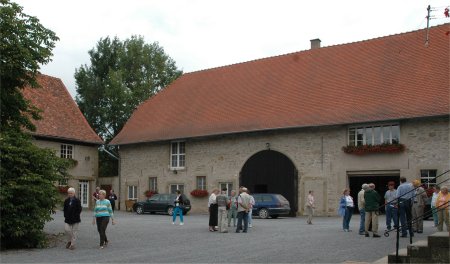
Rauhof |
Our earliest known ancestor was reportedly born at
the Rauhof in 1718. One source says that he was appointed as pastor of
the Hasselbach Mennonite congregation in 1731. If that is true, he
would have only been 13 years old when he was named pastor. It is much
more likely that his father was the pastor (or elder) of the Hasselbach
congregation in 1731. We do know that Abraham lived at the Rauhof for a
time, probably living there when he served as elder at Immelhausen and
Hasselbach.
Our ancestor Abraham Zeisset is discussed in the
Mennonite Encyclopedia as follows:
" Zeisset, Abraham (d. c1786) From 1749 an
elder of the Immelhausen (q.v.) and Hasselbach (
q.v.) Mennonite congregations in Baden, Germany. In 1783 (not
1773 as stated ME III, 14) he
moved to Willenbach ( q.v.) in Wuerttemberg and served the
Willenbach congregation until his
death. He played a role in the strife that developed among the South
German Mennonites to the
left and the right of the Rhine in the 18 th century. The
occasion for the disputes was the activity of
the strongly pietistic Mennonite preacher Peter Weber (q.v.) of
Hardenberg. Weber's justified
interest in awakening new life in the Mennonite congregations which
were in many cases
congealed in tradition met with opposition to the left of the Rhine
under the leadership of Jacob
Hirschler of Gerolsheim and a strongly conservative group; on the right
of the Rhine from 1766
on, Abraham Zeisset was his most active opponent. Contemporary
documents and letters about
that quarrel indicate that Zeisset certainly had the honorable
intention of preserving the old
Anabaptist individuality and of representing it with conviction. On the
other hand, it cannot be
denied that he was guilty of personal obstinacy and unbrotherly
attitudes.
The quarrel began when Zeisset deposed from their
office on the strength of his own authority the
preachers Georg and Abraham Bechtel, Jost Glueck, and Jakob Krehbiel,
who were spiritually
alive and were friends of Peter Weber. This created great offense in
the congregations of these
men. They feared a division similar to the one caused by Jakob Ammann (q.v.).
On Oct. 14 and
15, 1766, a conference took place at Rauhof in which three Swiss
Mennonites participated besides
the ministers of Baden and the Palatinate. Zeisset himself had invited
them. The peace that
resulted from this meeting was unfortunately of short duration. The
newly awakened disunity was
so severe that in 1767 the spring communion was not observed in North
Baden.
In 1770 a new effort was made to bring about peace at a
conference of elders and preachers on the
Himmelhaeuserhof (today Immelhaeuserhof). Zeisset and others leaders of
the dispute were set
back from communion "impartially and without respect of person" for
Easter of that year,
temporarily removed from the office of preaching, and asked to
apologize for their previous hostile
attitude. But the strife was not yet completely removed. Zeisset even
appealed to the civil
authorities for help. Not until 1782 was the affair settled.
Abraham Zeisset was also for a time engaged in
correspondence between the West Prussian and
the Southern German congregations. But after he had offended other
correspondents of the South
German congregations and did not succeed in drawing the West Prussians
to his side, he dropped
out of this circular letter. His relationship with the Swiss Brethren
on the whole remained clear,
although they were by no means on his side. In spite of the differing
judgments concerning
Zeisset, it must be reckoned as a service on his part that he
contributed to the closer union between
the South German Mennonites of the time and their Swiss brethren."
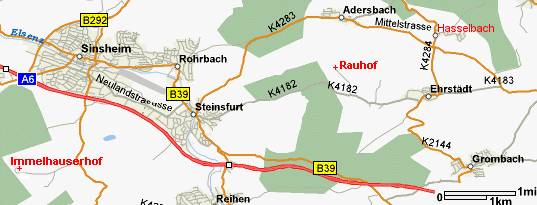
Map of Rauhof, Hasselbach, and Immelhauserhof |
Admittedly, this entry makes our ancestor sound
like a bit of a rascal. He was certainly a
man who was firm in his convictions. To further explain some of the
above text, the
Mennonite Encyclopedia provides insight into the practices of the time.
Communion was
not done at every church service. Prior to receiving communion, moral
integrity, unity
and peace were required of those who would be communing. In order to
assure the
appropriate attitude within the congregation, the Sunday prior to
Communion was set
aside to “cleanse” the congregation so that all would be ready the next
Sunday. If it was
not possible to meet the terms for communion, the congregation would
either not be
allowed to observe communion, or those who were not at peace with God
and their
fellow man would be asked to stay away. The congregation could actually
vote on
whether or not all should receive communion.
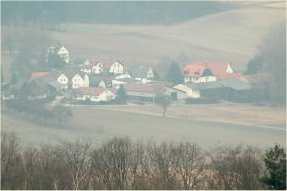
Immelhausen |
We can presume from the information
about Abraham Zeisset in the Mennonite Encyclopedia that his move to
Willenbach was
precipitated by the disagreements at Immelhausen.
Church records exist today through which we can
trace our ancestors to some degree. At
that time, the vital records (births, marriages and deaths) were
maintained by the clergy
of the local church. Because Mennonites were not recognized as a
church, their vital
statistics were compiled by one of the accepted churches: the
Evangelical (Lutheran),
Catholic or the Reformed Church. The clergyman may or may not have been
particularly
interested in maintaining these registers, so some records contain more
details than
others. The records are handwritten by the clergyman and may be in
Latin or German. The first challenge is to determine which parish kept
the records for the Mennonite
families. There may be additional frustrations in locating the oldest
church records. One
of the most commonly encountered reasons for missing records involves a
fire in which
all records were lost. And Germany, of course suffered through two
World Wars. To
date, records providing information about the Zeissets in Hasselbach
have not been
located. As noted previously, records of Mennonite births, marriages
and deaths were
not required until 1809.
We do know that the Zeisset family was living
in Willenbach in 1773. The information
from the Mennonite Encyclopedia provides 1783 as the year of Abraham
Zeisset’s arrival
there, but the Catholic church records from Willenbach list the birth
of a son in
Willenbach in 1773.
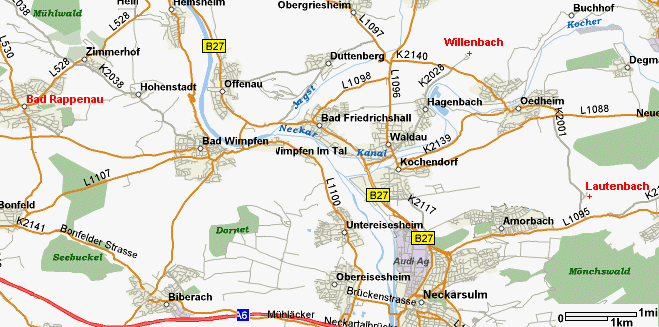
Willenbach, Lautenbach, and Bad Rappenau |

Willenbach |
Thankfully there are extensive records from
Willenbach. They are included in the
Catholic Church records from Ödheim. Ödheim is a small town just north
of Heilbronn. Willenbach is about 2 miles northwest of Ödheim. Another
Mennonite settlement
existed about 2 miles south of Ödheim called Lautenbach. Willenbach, as
Lautenbach,
was not a town, but a “Hofgut” or estate. A Hof is a farm or estate
where one or more
family units live.
In the late 17th century, Mennonites
were allowed to rent a farm for a period of 6-9 years. After proving
themselves as capable farmers of integrity, the time restriction was
abandoned, so that a Mennonite could lease a large estate and would
even pass the lease
onto his heirs. These estates were under the control of the feudal
lords, a condition which
allowed the tenants more freedom to try farming innovations than if the
estates had been
under local control by the villages. Among the crops grown by these
farmers were
potatoes for the manufacture of brandy and mangelwurzel, or mangels, a
type of beet
used for cattle feed. (Insert PHOTO OF BEETS) Mennonite farmers in
Germany became known for plant cultivation
as well as animal breeding. This was the occupation of our ancestors.
We know that both of these estates, Willenbach
and Lautenbach were later rented by the
Landes family. The Landes family was also of the Mennonite faith.
According to the
Mennonite Encyclopedia, in 1801 Duke Frederick granted the Mennonite
tenants of the
Lautenbach estate the right to lease some of his properties in
Wuerttemberg in exchange
for a “protection fee”. The history of Lautenbach as told by its recent
tenant indicates
that Lautenbach was built at the end of the 1700s and was given to the
German minister
to Paris. At that time, the property covered 1000 hectares (one hectare
= 2.471 acres). Now, in the 21st century, the property
covers only 200 hectares. Some of the buildings at
Lautenbach are original and some are newer. There is a long main
building. The owner
lived primarily in one end of this building. The servants would have
lived on the third
floor of the building. During WWII, according to the book One Farm, Two Wars, Three
Generations by Erica Hege Shirk, there were generally 100
persons living at Lautenbach. Lautenbach survived WWII, but Willenbach
was nearly destroyed. As is commonly
found in Europe, the old buildings are rebuilt even after heavy
destruction. In America,
we tend to demolish the remains to build something new. The manor house
at
Willenbach was built in 1603 by Hans Wolf Capler of Ödheim (the nearby
town). There
were 150 hectares (about 370 acres) with this estate. Some time after
the Zeisset family tenure, the property was used as part of a sugar
factory. Then, in 1925, Walter Landes rented the Willenbacher Hof, and
the Landes family has continued to rent the Hof since then, according
to Günther Landes, a resident in 2006.
[Insert family chart here]
Abraham Zeisset and his wife, Elisabetha Landes
(1720-?) of Zuzenhausen had at least
eight children together. The last child was born at Willenbach in 1773.
They had three
daughters and five sons. The daughters were Anna (1748-1818), Barbara
(1754-1806)
and Elisabetha (1770-1816). The sons were Abraham (1755-1808), Samuel
(1757-1807),
Jakob (1764-1813), Isaak (c 1766-1843) and Cornelius (1773-1811). There
is a notation
in the church record in Latin which states that Abraham Zeiset Senior,
Anabaptist, 69
years of age, born in Rauhof, died on the 25th of April
1787. His wife appears to still be
living at that time. The oldest daughter, Anna, married Heinrich
Mosemann. This couple
lived at Lautenbach, where Anna died in 1818. The second daughter,
Barbara, married
Christian Schmutz, the elder and lived with him in Rappenau [see
map above]. The third daughter,
Elisabetha, also lived at Rappenau with her husband Jakob Moser.
The oldest son of Abraham and Elisabetha Zeisset
was also named Abraham. He married
and raised his family at Willenbach, dying there in 1808. Abraham (the
younger), first
married Christina Pletscher. This couple had four children before
Christina’s death in
1787 at Willenbach.
The oldest daughter of Abraham (the younger) and
Christina Zeisset
was Barbara Zeisset who later married Heinrich Baer
at Dammhof in 1798, making the
first known Baer-Zeisset relationship.
The only son of Abraham (the younger) and
Christina Zeisset was Johannes Zeisset (1786-1825).
Johannes Zeisset married
Magdalena Schmutz in 1812. The youngest son of Johannes and Magdalena
was named
Jacob, born in Menzingen in 1825. This Jacob was one of the first of
our Zeissets, that
we know of, to emigrate to America. He arrived sometime in April 1850
and changed his
name to Jacob Zeisert. Living first in Ohio, he
married Elizabeth Stock and then moved
to Lenawee County, Michigan. Jakob Zeisert may have emigrated to Ohio
to join a grandson of Abraham Zeisset and Elisabeth Landes. A man named
Christian
Zeisset lived in Randolph Twp., Montgomery County, Ohio and matches the
age of Christian Zeisset the grandson of Abraham and Elisabetha Zeisset
(son of Isaak
Zeisset and Magdalena Mosemann), but the connection has not been
definitively made. The Zeisset
descendants in Michigan continued the struggle with the spelling of the
name. Records
are found in Germany with the spelling Zeisert and the Michigan family
is certain that
this is the original spelling. Variations found in the Michigan family
include Seizert,
Zeisert, Zeiszert and Zeizert.
The father of Johannes, Abraham Zeisset (the
younger), was married to his second wife, Magdalena Fellmann, in
January 1788 quite
likely at Willenbach. This couple had nine children, with only four
daughters surviving. They married men with the names Bühler, Hodel,
Mosemann, and Frey.
The second son of Abraham Zeisset (the elder) and
his wife Elisabetha was named
Samuel. Samuel was married to Katharina Fellmann and
lived at Lautenbach where he
died in 1807. Interestingly, the funeral sermon for Samuel was compiled
in a document
with another funeral sermon. This piece is entitled “Predigten eines
Mennoniten-Predigers in Württemberg, 1830”. There’s actually a much
longer title which in
translation is: “Two funeral orations from 1) the death of the
Mennonite-Preacher
Samuel Zeisset, of Lautenbach, and 2) the death of the wife of
Christian
Hunzinger…/from Cornelius Zeisset”. This document can be found in the
Bethel
College Library in Newton, Kansas.
The third son, Jakob, ancestor of
the Kansas Zeissets, is discussed in the following chapter.
The fourth
son, Isaak, raised his family (five sons) at
Willenbach, where his wife, Barbara Hodel
died. Isaak Zeisset, however, died at the Hettstädterhof just outside
of Würzburg in
1843. Isaak and Barbara were probably the parents of the Christian
Zeisset who emigrated
to Ohio and was the ancestor of the Zizert family in Ohio.
The fifth son of Abraham Zeisset (the elder), Cornelius
Zeisset, was born, married
to Elisabetha Heer and died at Willenbach in 1811. He is the Cornelius
Zeisset referred
to in the previous paragraph. Only one of his seven children survived
to adulthood, and
was also named Cornelius. It should be noted that at this time in the
early 19th century,
infant mortality among the Zeisset family in Willenbach was high. For
instance, only
four of the nine children of Abraham Zeisset, the younger, and his
second wife survived infancy, and they were all
daughters, so the Zeisset name did not carry on from this line.
Abraham Zeisset, the younger, and his first wife were the parents of
four children, one of whom was Jacob Zeisert, who emigrated to Ohio and
then Michigan. Another was Barbara Zeisset (1780-1832) who married
Heinrich Baer (1778-1853).
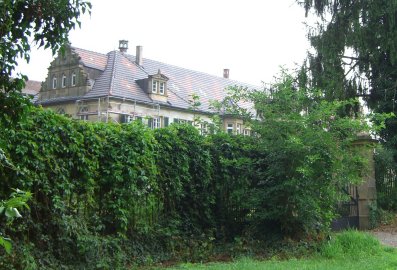
Lautenbach manor house |
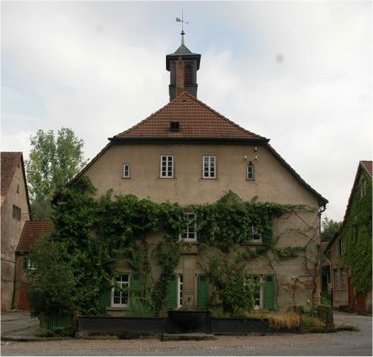
Lautenbach building where Zeissets probably
lived |
We now follow the direct ancestors of the six
immigrant Zeissets. Jakob Zeisset (1764-1813), son of Abraham (the
elder) was born at Rauhof in 1764, moved to Lautenbach in
1773 and married Magdalena Plätscher of Meckesheim in 1785. Jakob
Zeisset was a co-tenant farmer (mitpächter) at Lautenbach, presumably
working with his brother, Samuel. Jakob and Magdalena had eleven
children, seven of whom died in infancy or childhood. One of the
surviving children was a daughter: Magdalena (1792-1850) who married
Abraham Bühler, then Isaak Fellmann and eventually died in Bruchhausen,
a town
southwest of Heidelberg.
Of the sons of Jakob Zeisset (1764-1813) and
Magdalena Plätscher, the first was
Abraham (1787-1817) who died in Lautenbach in 1817. Johannes
(1794-1855), the
second son to survive, was also born at Lautenbach and will be
discussed in the
following chapter. The third son to survive was Isaak Zeisset (b.
1803). No other
information has been found discussing Isaak.
The next generation, born in the late 18th and
early 19th centuries, becomes much easier to trace. It is during this
time that the Mennonites were consistently included in the church
records.
Continue to Chapter 2









